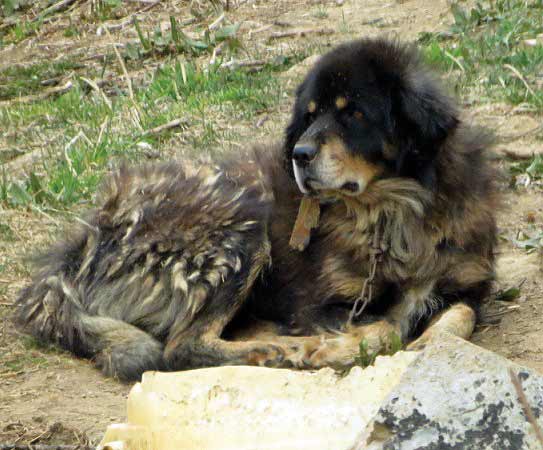What’s for breakfast?
In 1966, Regon Unsoeld and I, with our friend Terry Bech and my Tibetan mastiff dog ‘Amjo’, trekked from Pokhara (before roads) north to Thak Khola in Mustang District. Regon was the 14 year old son of the (then) Nepal Peace Corps Director and Everest summitter, Willi Unsoeld. Terry and I, in our 20s, had recently completed two years as Peace Corps volunteers. While in Thak Khola we stayed with Thakali friends in Marpha village (8,750ft) and took side trips up into the mountains.

Our longest hike was from Marpha up to Dhampus Pass (17,000ft), an altitude gain of 8,250 ft. We went straight up and over Batasi Danda (‘Windy Ridge’) which is noted for both high winds and dense fog and white-outs. On day 2 we traversed west to the pass on what is now called the Dhaulagiri Circuit Trail. We carried our camping gear and food, including a supply of dog food kibble.
On the way up and back we encountered yaks and chauri-gai (yak-cow crossbreeds) in the pastures. And over the pass in the ‘Hidden Valley’ we also came upon a very wary and skittish herd of feral yaks roaming unattended.
The yaks excited Amjo! And when we ran out of dog food, he ate their dung patties! Meanwhile, near one yak and chauri herders’ camp one morning we were offered something quite unexpected for breakfast...
Afterward, Regon wrote up the story of our trek. It was printed in the AWON Bulletin (of the American Women of Nepal group in Kathmandu). Here is Regon’s story.
“We were returning from Dambush [Dhampas] Pass and had spent the night in a wodar, a cave-like shelter. Rain had fallen in the night, and we had gotten soaked. Now the three of us were following a small trail through the dense fog at about 14,000 feet. Every once in a while the swirling mists would hide us from each other’s view. We stopped on a ridge crest to decide which route back to Marpha we were going to take. As we stood there, a small shadow figure, which appeared to have a pointed head, came towards us out of the clouds. It was a man wrapped in a blanket. We asked him the best way to Marpha, and he waved his arms vaguely in three directions. Then he asked why we didn’t go on down to his goth (a yak-herder’s small temporary quarters). We could get some milk there he said, so we left him and followed the ridge crest downhill for about 300 feet.
“Suddenly we found ourselves surrounded by maybe 60-80 yak. We found the goth without too much trouble and were startled to see six men crowding around a yak [chauri] that they had hog-tied and laid on the ground. One of them had a six-inch razor; and as we stood shivering in the cold, he plunged it in the yak’s neck. At first we thought they were to remove a goiter that the yak had, but one of the men said they weren’t doing that. All at once a spurt of blood gushed out of the yak’s neck. To our surprise, instead of stopping the flow of blood, all the men grabbed their cups and, running in, began to fill them up. Then they drank the stuff and threw out the clots that formed at the bottom. We were offered some by them as they grinned at us with blood-smeared mouths, but we didn’t feel like having any for some reason.
“After several rounds apiece, they cut the yak loose. As it staggered to its feet, it had lost several quarts of blood by now, a fresh flow started and they filled their cups once more. After the men put a little yak dung on the wound, the yak walked off and disappeared into the herd and fog. It would probably supply the men with several more breakfasts before its time was up.”










